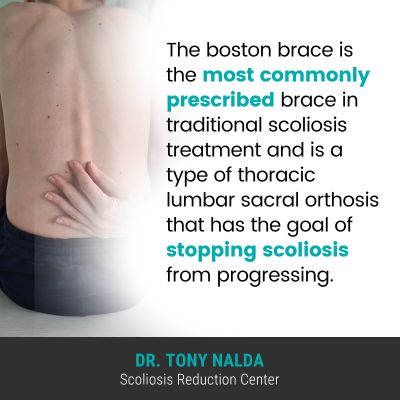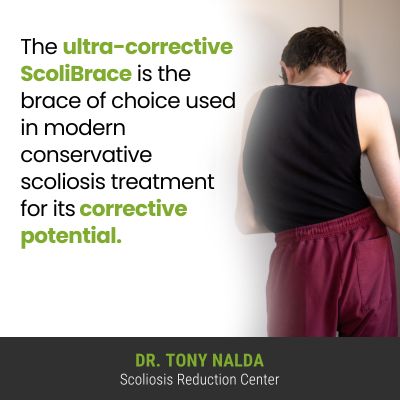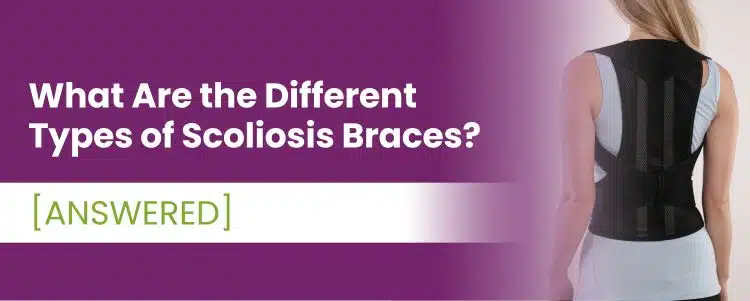The most common full-time brace used in traditional scoliosis treatment is the boston brace, and the ScoliBrace is the ultra-corrective brace of choice applied in conservative treatment. The different brace types have different treatment goals; traditional treatment has the goal of stopping progression, while conservative treatment has the goal of correcting scoliosis.
There are different scoliosis treatment approaches, and each reflects a different approach to bracing as a facet of treatment. Traditional scoliosis bracing is associated with a number of shortfalls that modern corrective bracing addresses.
As a different type of brace is used by the different scoliosis treatment approaches, let’s start by comparing traditional and conservative scoliosis treatment approaches
Traditional vs Conservative Scoliosis Treatment
There are different ways to treat scoliosis, and as an incurable and progressive spinal condition, the way a diagnosis of scoliosis is responded to with treatment can shape a patient’s long-term spinal health and function, and by extension, their overall quality of life.
As a progressive condition, scoliosis has it in its nature to get worse over time, and this involves the size of the unnatural spinal curve increasing, as do the condition’s uneven forces, and their effects.
The main condition effect in children is postural deviation, and in adults, it’s back pain and pain that radiates into the extremities due to nerve compression.
Scoliosis ranges widely in severity from mild to moderate and severe to very severe scoliosis, and this is also the condition’s progressive line.
Traditional Scoliosis Treatment
Traditional scoliosis treatment doesn’t have a strategy for addressing scoliosis while mild so commonly introduces bracing at the moderate level, and this is done to stop scoliosis from progressing: the same goal as traditional surgical scoliosis treatment.
Traditional treatment and bracing doesn’t have the goal of correcting a scoliosis, but instead focuses on stopping the condition from getting worse, which is why traditional treatment is considered more reactive than proactive because it only responds to progression, rather than working towards preventing it.
Conservative Scoliosis Treatment
Conservative scoliosis treatment is proactive, so it works towards preventing progression, increasing condition severity and effects felt throughout the body.
Conservative scoliosis treatment has the goal of correcting scoliosis on a structural level, which is different from traditional treatment’s goal of stopping scoliosis from progressing.
Conservative treatment is started as close to the time of diagnosis as possible because I feel it’s more effective to proactively work towards preventing progression and increasing condition effects, than it is to attempt to reverse them once they’re established.
Modern conservative treatment has the goal of helping patients avoid a surgical recommendation because even when successful at stopping scoliosis from progressing, spinal fusion surgery is a costly, lengthy, and invasive procedure that often costs the spine in terms of its long-term strength and function.
So now that we’ve discussed the fundamental differences between traditional and conservative scoliosis treatment, let’s address the differences between some of the most common full time braces.
The Boston Brace

The boston brace is the most commonly prescribed brace in traditional scoliosis treatment and is a type of thoracic lumbar sacral orthosis that has the goal of stopping scoliosis from progressing.
The boston brace works via a type of three-point pressure system that squeezes the spine unnaturally to force it into a more aligned position, but this type of excessive spinal pressure is known to actually weaken the spine over time.
Most boston braces are prescribed for full time wear, which can mean for up to 23 hours a day for up to five years, so this also means sleeping in the brace, and no brace can be effective if it’s not being worn exactly as prescribed.
The boston was created in the ’70s, and its design has changed little over the years, despite our growing understanding of scoliosis brace efficacy.
The boston is made from rigid plastic and is mass produced, and this makes the brace bulky and uncomfortable to wear, which causes compliance issues associated with rigid braces.
While there are different types of scoliosis a patient can develop, the most prevalent type overall is adolescent idiopathic scoliosis, diagnosed between the ages of 10 and 18, and as growth is what triggers progression, this age group is the most at risk for rapid-phase progression; this age group is also one that wants to blend in with their peers, hence compliance being a common issue.
There are also scoliosis braces that are designed to be worn specifically at night, and the most common nighttime brace is the Charleston bending brace.
Charleston Bending Brace
The most commonly prescribed nighttime braces is the Charleston bending brace, and this brace is customized based on a cast taken of a patient’s torso.
After the cast is set, corrective forces specific to the curvature type are added to the brace in conjunction with a series of measurements of the spine obtained during X-ray.
Nighttime braces like the Charleston brace are designed to be worn while lying down, not while upright and during movement; the brace applies lateral and rotational forces to hold the spine in an over-corrected position.
Regular braces that are worn full time during the day and night can’t have the same level of corrective forces applied because they have to account for movement and the position of the head over the torso: those factors are eliminated while sleeping.
Holding the spine in an overcorrected position can help counteract the condition’s progressive nature that’s causing the spine to bend and twist unnaturally.
The Ultra-Corrective ScoliBrace

The ultra-corrective ScoliBrace is the brace of choice used in modern conservative scoliosis treatment for its corrective potential.
The ScoliBrace works by pushing the spine into a corrective position, and this is known to adjust the spine’s alignment without weakening it, and the ScoliBrace also uses state-of-the-art scanning technology to ensure that each brace is bespoke to its wearer.
ScoliBraces are fully customized to suit a patient’s specific body and curvature type.
The main shortfall of the traditional boston brace that’s addressed in the design of the ScoliBrace is the 3-dimensional nature of the condition; the boston brace ignores the condition’s rotational forces so only addresses it as 2-dimensional, limiting its potential efficacy.
The ScoliBrace isn’t known to weaken the spine, and as it’s customized to each individual patient, it’s less bulky, more comfortable to wear, and less noticeable beneath clothing, so compliance rates are higher.
Conclusion
In order to achieve maximum curve correction, an integrative treatment approach is necessary as the complex nature of the condition necessitates the complete customization of treatment plans.
While most full time braces have to be worn during the day and night, nighttime braces have the goal of over-correcting during the night, when movement and positioning aren’t as important, so the focus can involve applying pressure to the spine during sleep, when it’s likely to not be as noticeable for the patient.
I do want to be clear, however, that no scoliosis brace on its own is enough to actually correct a scoliosis; only when bracing is combined with other facets of condition-specific treatment can corrective treatment results be achieved.
When combined with chiropractic care, physical therapy, and rehabilitation, corrective bracing can help augment corrective treatment results by pushing the spine into a corrective position.
Chiropractic care can work towards adjusting the position of the curve’s most-tilted vertebrae back into alignment with the rest of the spine, while physical therapy can help increase core muscle strength for improved spinal support and stabilization.
Rehabilitation can involve a series of prescribed home exercises to further heal and stabilize the spine, and corrective bracing is known as particularly effective on growing spines so is a common facet of treatment for childhood scoliosis.
Scoliosis braces are also used to treat adult scoliosis, but the focus is different, and braces are used more to stabilize the spine and for short-term pain management, than for correction.
Regardless of age, condition type, or severity, the best way to manage scoliosis is proactively so progression and increasing condition effects can be avoided, along with the risks associated with surgical treatment, and scoliosis bracing can be an important facet of treatment.
Here at the Scoliosis Reduction Center®, my patients benefit from a proactive conservative scoliosis treatment approach, and when a scoliosis braces is deemed helpful as part of treatment, I prefer the ultra-corrective ScoliBrace; this braces represents the culmination of what we’ve learned about scoliosis, scoliosis bracing, and brace efficacy.
While there are different types of scoliosis braces, not all are created equal, and patients need to educate themselves on the pros and cons of each, as well as the different potential results offered by traditional versus conservative scoliosis treatment.




